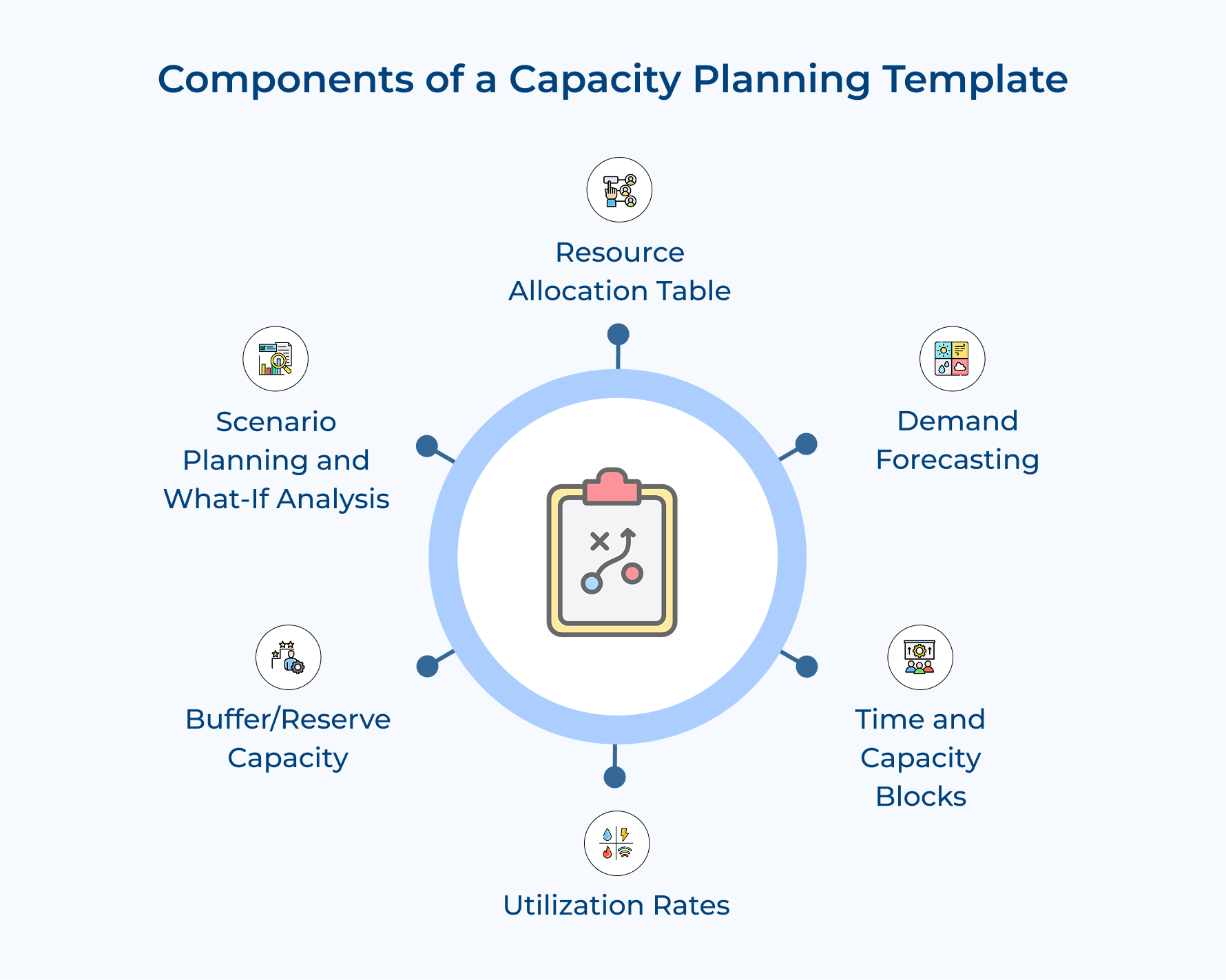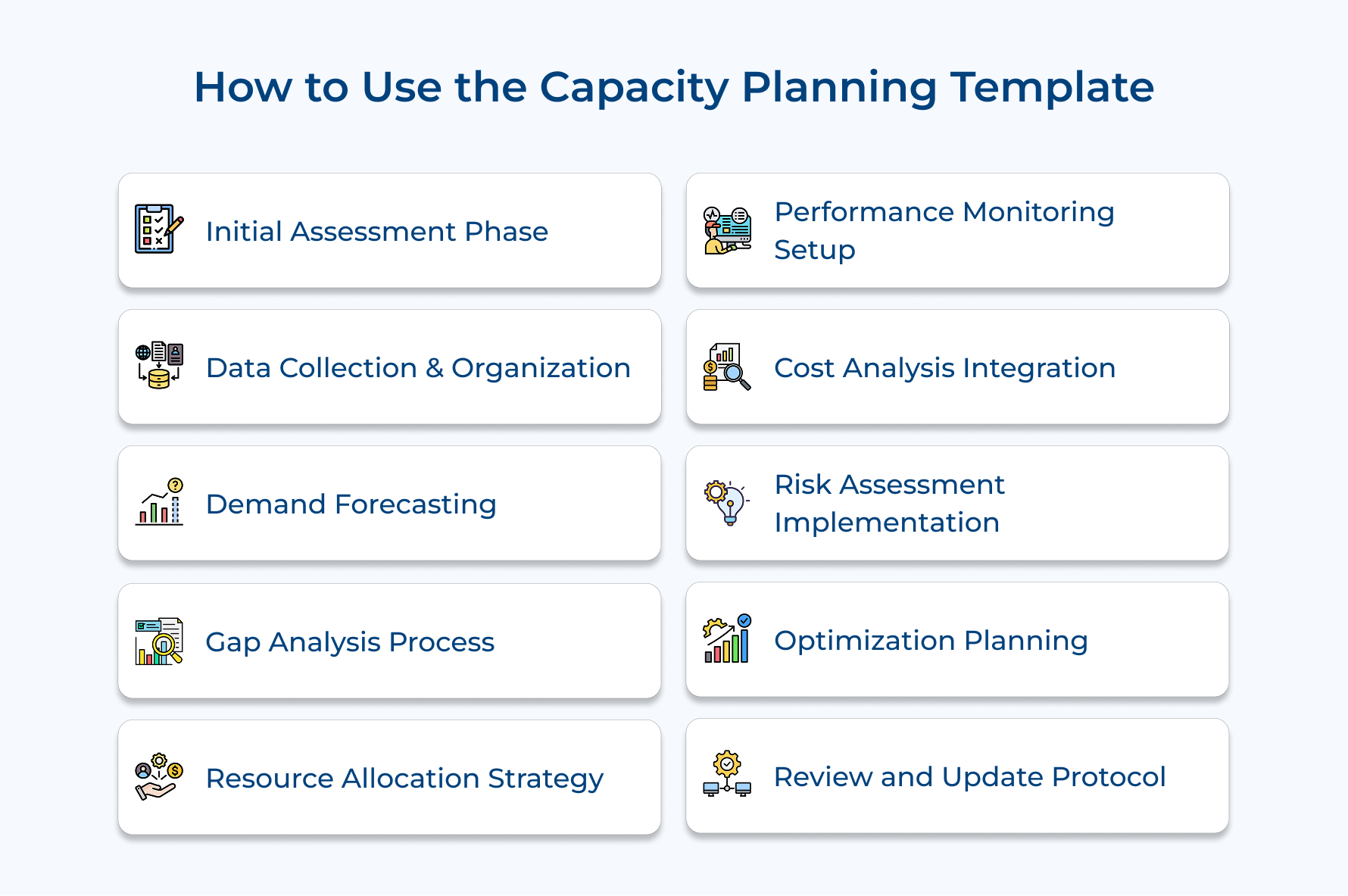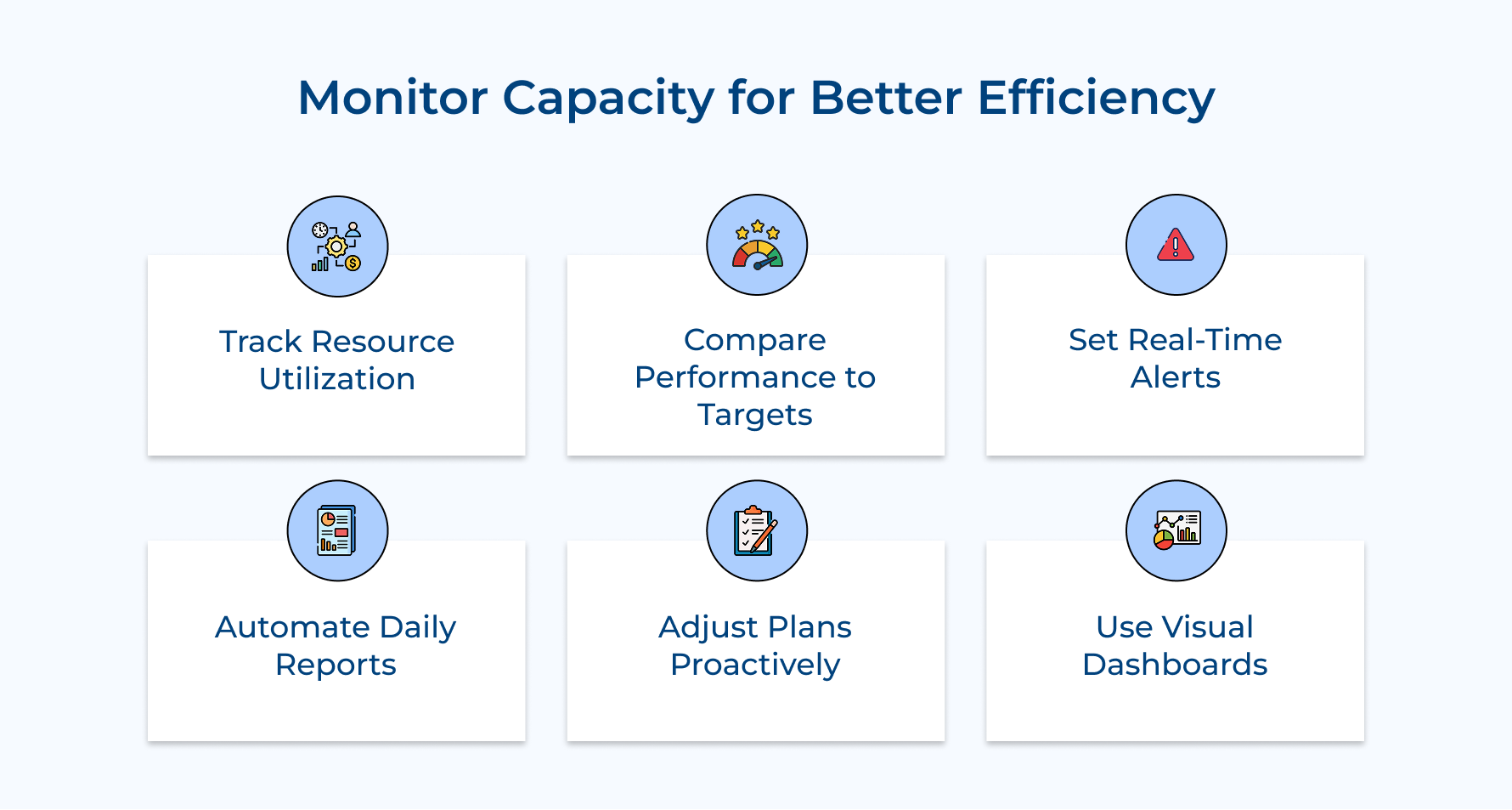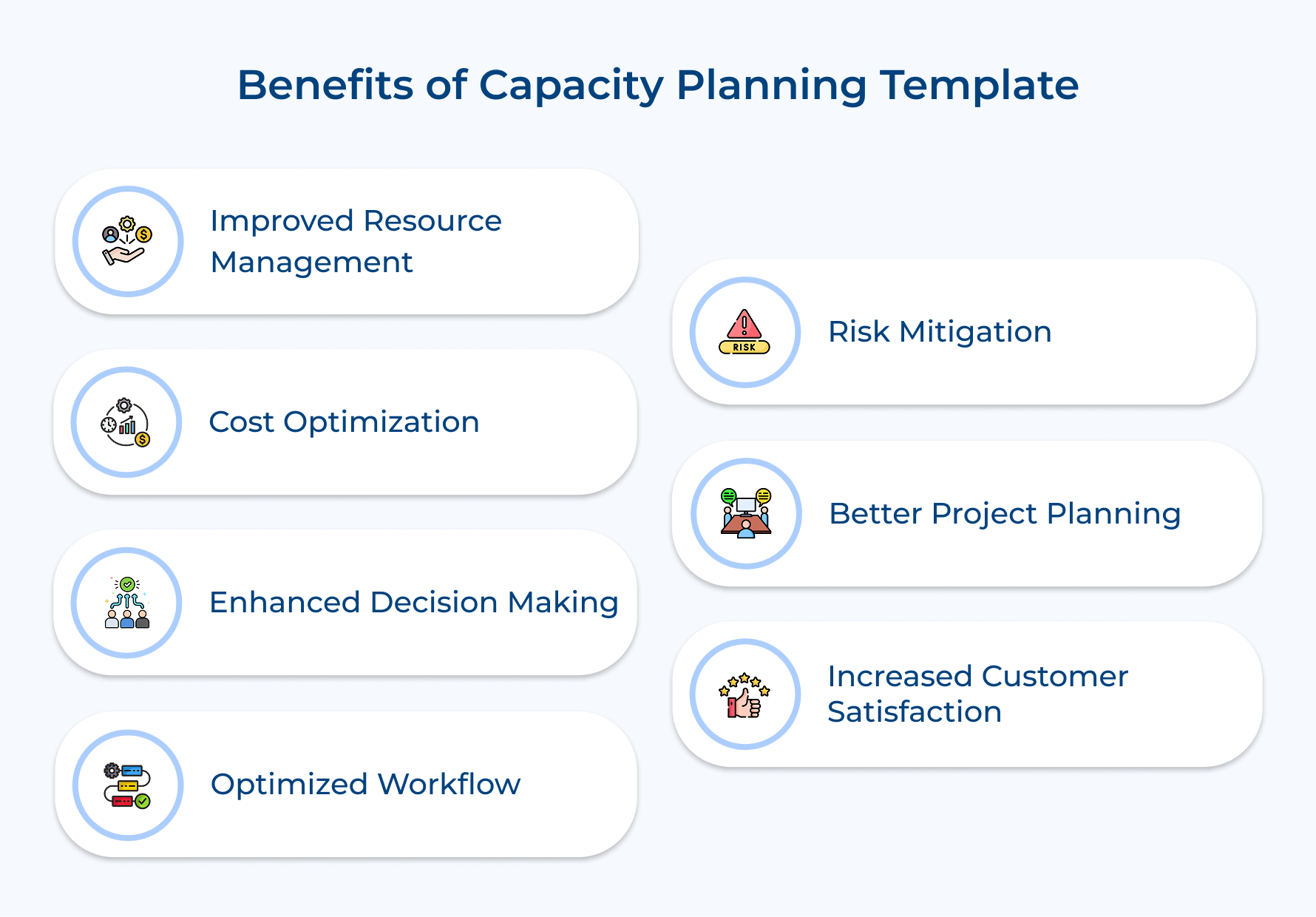Capacity Planning Template to Manage Bandwidth in 2025

Key Highlights:
- Capacity planning template helps allocate resources effectively to avoid bottlenecks and optimize workforce, equipment as well as tech utilization.
- Forecast potential shortfalls and implement strategies to prevent disruptions, ensuring smooth operations.
- Leverage data-driven insights and historical trends for confident, strategic decisions on staffing as well as budgeting.
When teams are stretched too thin or assets sit idle, project progress slows, productivity tanks, and client satisfaction takes a hit. Poor resource management doesn’t just mess with the current goals—it can hold back your business growth in the long run.
That’s where a robust capacity planning template comes in. It helps you stay ahead of the curve by forecasting resource needs, balancing workloads, and making sure your team has exactly what they need to deliver.
Let’s dive into how a capacity planning template can simplify your operations, boost efficiency, and set your business up for sustainable growth. Let’s get started!
What Is a Capacity Planning Template?
A capacity planning template is a structured document or framework that helps organizations systematically forecast and manage their resource requirements to meet current as well as future business demands. It serves as a strategic tool that outlines the organization’s available resources and maps them against projected needs over a specific period.
Clear visualization of resource utilization helps prevent both overutilization and underutilization. Proper template usage facilitates better budget planning, helps maintain service quality standards, and supports strategic growth initiatives by ensuring that necessary resources are available when needed.
Key objectives of capacity planning templates include:
- Resource optimization: Maximize the efficient use of existing resources while minimizing waste and redundancy.
- Risk mitigation: Identify potential capacity shortfalls or excesses early to prevent operational disruptions and financial losses.
- Cost control: Enable better budget planning through accurate resource need forecasting and avoiding last-minute resource acquisition at premium prices.
Key Components of a Capacity Planning Template
A great capacity planning template helps you stay ahead by balancing production capacity, resource availability, and future projects seamlessly. Let’s break it down!
1. Resource Allocation Table
The resource allocation table is your go-to snapshot of everything you’ve got to work with—staff, equipment, materials, and even finances. It organizes all your resources and shows what’s available at any given time.
For example, with human resources, you can track each employee’s role, skills, hours, and workload. For equipment or space, you’ll see availability and constraints like maintenance schedules. This big-picture view helps you balance workloads and avoid overloading anyone—or anything.
2. Demand Forecasting
Predicting future needs is a game-changer. A good capacity planning template includes a section for demand forecasting, which uses historical data, market trends, and upcoming projects to predict how much capacity you’ll need.
For instance, a consulting firm might forecast client projects for the next quarter, while a manufacturer might project raw material needs for the year. Add in seasonal trends or project timelines, and you’re set to allocate resources effectively.
3. Time and Capacity Blocks
Time-based planning is key for staying on track. This section maps out resource availability over days, weeks, or months, highlighting high-demand periods or potential shortages.
Imagine a marketing agency gearing up for multiple launches in one month. Time blocks can reveal if they’ll need extra hands or equipment to meet deadlines. It’s all about smarter scheduling and avoiding chaos during busy times.
4. Utilization Rates
How well are your resources being used? Utilization rates answer that question, giving you insights into if your team, equipment, or budget is being stretched too thin—or sitting idle.
For example, if an employee is constantly maxed out, it might be time to hire help. If machinery is barely used, you could reallocate or cut costs. Keeping an eye on utilization rates ensures everything’s running efficiently.
5. Buffer/Reserve Capacity
Surprises happen—if it’s a sudden spike in demand, an unexpected absence, or a last-minute project change. That’s why buffer capacity is essential.
Think of it as your safety net. A software company might keep 10% of developer capacity in reserve for emergency bug fixes, while a retailer might stock extra inventory for seasonal demand spikes. A little cushion keeps things running smoothly, no matter what.
6. Scenario Planning and What-If Analysis
What happens if demand doubles next quarter? Or if a key team member becomes unavailable? Scenario planning helps you prepare for the unexpected.
The component lets you map out “what-if” situations, assess risks, and create backup plans. By thinking ahead, you’ll minimize disruptions and handle surprises like a pro. A well-rounded capacity planning template is your ticket to smoother operations, better resource use, and less stress.
How to Use the Capacity Planning Template
Using a capacity planning template is easier than you think! Here’s a simple guide to help you optimize resources and meet project demands seamlessly.
Initial Assessment Phase
The first step in using a project capacity planning template is figuring out where you stand right now. This means taking a close look at your organization’s current capacity—documenting available resources, analyzing workflows, and understanding operational capabilities across the board.
Why is this important? Because without a clear picture of your starting point, planning for future capacity needs is like shooting in the dark. The phase helps you spot inefficiencies, underused resources, and areas that could use some improvement—all key to better decision-making.
Here’s how to get started:
- Make a detailed inventory of all your resources, from people and equipment to finances. Include how they’re being used right now.
- Talk to department heads to get the inside scoop on challenges as well as bottlenecks.
- Dig into your data to identify trends in resource usage and set benchmarks for performance.
Pro Tips:
- Use a standardized checklist to cover every resource category and run monthly audits to keep things up to date.
- Form a cross-functional team to gather insights from all departments—because no one knows your operations better than the people running them!
Data Collection & Organization
Once you’ve assessed your capacity, the next step is collecting all the data you need in one place—and making sure it’s standardized. It means gathering information from across your organization and plugging it into your template in a way that’s easy as well as consistent.
A well-organized data is the backbone of accurate capacity planning. When everything is standardized, you can compare data across departments, spot trends, and make smarter, data-driven decisions about resource allocation.
Here’s how to make it happen:
- Automate where you can. Set up systems to collect data automatically and save time.
- Use standardized forms for any manual data entry to keep things consistent.
- Organize your data into clear categories and validate it regularly to avoid errors.
Actionable Tips:
- Build a centralized data hub with clear naming conventions, so everything’s easy to find and understand.
- Schedule weekly data checks and assign a “data quality champion” to your team to keep everything running smoothly.
Demand Forecasting
Predicting future resource needs doesn’t have to feel like guesswork. By looking at past trends, analyzing the market, and factoring in projected business growth, you can create a plan across all operational areas.
Accurate demand forecasting helps you stay ahead. It prevents resource shortages or overloading by anticipating what you’ll need. That means smoother operations, better service during busy times, and smarter use of resources.
Start by digging into historical data and spotting patterns. Layer in market trends and use statistical forecasting tools to sharpen your predictions. Don’t forget to account for seasonal ups and downs or potential shifts in your business.
Tips to consider:
- Implement rolling forecasts updated monthly to maintain accuracy and adjust for changing conditions.
- Use multiple forecasting methods and compare results to improve prediction accuracy.
Gap Analysis Process
It’s essential to assess capacity gaps and plan accordingly to stay ahead in operations. Here’s how you can do it.
- Compare now vs. Future needs: Look at your current capacity and stack it against what you’ll need. This helps spot resource shortages or surpluses across your operations.
- Focus on what matters: Gap analysis shines a light on areas that need urgent attention, so you can prioritize where to invest in capacity.
- Avoid disruptions: By catching potential shortages early, you can dodge operational hiccups and plan for smooth sailing.
- Visualize the gaps: Create side-by-side comparison charts showing current vs. needed resources. Highlight the gaps clearly and develop action plans to tackle them step by step.
Pro Tips:
- Create a color-coded gap visualization system to quickly identify critical areas needing attention.
- Establish monthly gap review meetings to track progress and adjust strategies as needed.
Resource Allocation Strategy
A strategic resource allocation plan ensures that available resources are distributed efficiently across business functions, based on priorities and operational needs. It helps prevent bottlenecks, maintain efficiency, and achieve business objectives.
The team’s availability is key to assessing current resources and aligning them with project teams. Implementing systems for optimal scheduling and tracking resource utilization ensures smooth operations as well as balanced resource distribution, enhancing overall efficiency.
Tips to consider:
- Create clear allocation priority guidelines and update them quarterly based on business needs.
- Implement a resource booking system with built-in conflict resolution protocols.
Performance Monitoring Setup
Keep operations on track by monitoring capacity utilization and performance against set targets. A systematic framework helps ensure efficiency and supports continuous improvement.
How to keep track of your resources effectively?
- Monitor capacity & efficiency: Use a framework to track how well your resources are being used and compare performance to benchmarks.
- Stay proactive: Performance monitoring lets you spot issues early, so you can adjust plans as needed before they become problems.
- Real-time insights: Automated tracking systems give you live data on resource use, keeping everything running smoothly.
- Keep improving: Dashboards will show current capacity usage, and alerts can notify you when thresholds are crossed. Thus, helping you stay on top of things and push for continuous improvement.
Actionable Tips:
- Set up automated daily performance reports with key metrics highlighted for quick review.
- Create a tiered alert system with specific response protocols for different threshold violations.
Cost Analysis Integration
A strong financial tracking system is key to managing capacity planning effectively. It helps you keep an eye on resource costs, investments, and returns, ensuring everything stays within budget.
You can make smarter decisions on resource allocation, spot savings, and justify capacity-related expenses just by analyzing costs.
Set up detailed cost-tracking methods for each element, and build financial models to evaluate different scenarios as well as their cost impacts, guiding more informed decisions.
Pro Tips:
- Implement monthly cost-benefit reviews for each major capacity resource category.
- Develop ROI calculators specific to different types of capacity investments.
Risk Assessment Implementation
A strong risk management approach helps safeguard your capacity planning and resource allocation. By identifying and addressing potential risks early, you ensure smooth operations as well as long-term success.
- Evaluate potential risks: Use risk matrices to assess different capacity scenarios and understand possible impacts.
- Proactive mitigation: Develop strategies to manage risks and avoid disruptions.
- Update regularly: Conduct risk reviews often and adjust contingency plans to keep up with changing conditions.
Tips to consider:
- Maintain a dynamic risk register with quarterly updates and review sessions.
- Develop scenario-based contingency
- plans for the top three identified risks.
Optimization Planning
A strategic process for identifying as well as implementing improvements in capacity utilization, resource efficiency, and operational performance.
Optimization planning helps maximize return on capacity investments and improve operational efficiency. It supports continuous improvement initiatives and helps maintain competitive advantage through better resource utilization.
Conduct regular efficiency audits and identify improvement opportunities. Implement pilot programs for optimization initiatives while also tracking their effectiveness.
Actionable Tips:
- Schedule monthly optimization workshops with key stakeholders to identify improvement areas.
- Create an optimization initiative tracker with clear success metrics and timelines.
Review and Update Protocol
Regular evaluations and updates are essential to keep your capacity planning relevant as well as effective. It ensures plans stay aligned with your business needs and the ever-changing market landscape.
- Set review cycles: Establish regular intervals to assess different capacity planning elements.
- Gather feedback: Use feedback mechanisms to capture insights from your team and operations.
- Implement improvements: Continuously refine your processes and data to enhance accuracy as well as effectiveness.
Pro Tips:
- Implement quarterly comprehensive reviews of capacity planning effectiveness.
- Maintain a continuous improvement log with scheduled actions and responsible parties.
Benefits of Capacity Planning Template
A capacity planning template streamlines the process of resource allocation and forecasting. It provides a clear, organized way to track and manage resources, ensuring efficiency.
Improved Resource Management
A capacity planning template helps you allocate and track resources strategically to avoid bottlenecks while making the most of your workforce. It helps you manage everything from staff and equipment to tech assets, ensuring you’re ready to meet current as well as future demands.
Cost Optimization
Get clear insights into how your resources are being used. This helps cut unnecessary expenses, make smarter investments, and allocate budgets more effectively. Financial teams can use the template to track spending as well as avoid waste across departments.
Enhanced Decision Making
Data-driven insights make decision-making easier. Whether it’s hiring staff or purchasing equipment, the template provides reliable forecasts and historical data to guide strategic choices confidently.
Optimized Workflow
The template helps streamline operations by forecasting workload demands. Knowing your resource availability allows teams to focus on high-priority tasks, improving efficiency and minimizing delays.
Risk Mitigation
Stay ahead of potential issues by identifying shortfalls before they disrupt operations. The template’s forecasting tools enable proactive risk management, helping protect against challenges and maintain business continuity.
Better Project Planning
Plan projects more effectively by aligning schedules with available capacity. The template ensures realistic timelines, prevents resource conflicts, and helps project managers keep productivity high across multiple initiatives.
Increased Customer Satisfaction
Having the right capacity in place, you can consistently meet customer demands, even during busy periods. The template lets you anticipate and prepare for demand fluctuations, keeping service quality high as well as customers happy.
Maximizing Efficiency with a Well-Designed Capacity Template
Mastering capacity planning through well-structured templates proves crucial for organizational success. Strategic implementation transforms resource management challenges into clear, actionable insights.
Organizations leveraging comprehensive templates gain abilities to forecast demands and optimize resources effectively. Regular monitoring keeps plans relevant to changing business dynamics.
Companies embracing structured capacity planning position themselves for long-term success through improved efficiency. Committed leadership teams recognize capacity planning templates as essential tools for driving sustainable growth.
Limit time — not creativity
Everything you need for customer support, marketing & sales.
Neeti Singh is a passionate content writer at Kooper, where he transforms complex concepts into clear, engaging and actionable content. With a keen eye for detail and a love for technology, Tushar Joshi crafts blog posts, guides and articles that help readers navigate the fast-evolving world of software solutions.



